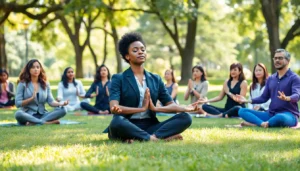Table of Contents
ToggleIn a world buzzing with distractions, mindful seeing offers a refreshing escape. Imagine taking a moment to truly see the world around you, not just a blur of colors and shapes. It’s like putting on a pair of magical glasses that transform the mundane into the extraordinary. Suddenly, that cup of coffee isn’t just a caffeine fix; it’s a warm hug in a mug, inviting you to savor every sip.
Mindful seeing isn’t just about looking; it’s about experiencing. It’s about noticing the intricate details of a leaf or the laughter lines on a friend’s face. This practice can turn everyday moments into mini-adventures, making life feel richer and more vibrant. So, why not trade in the autopilot mode for a little mindful exploration? After all, the world’s a masterpiece just waiting for someone to take a closer look.
Understanding Mindful Seeing
Mindful seeing involves observing the world without distractions. This practice enhances appreciation for life’s experiences and transforms everyday moments.
Definition of Mindful Seeing
Mindful seeing refers to engaging with one’s surroundings through focused awareness. This approach cultivates attention to various details, such as colors, shapes, and textures. By fully immersing in observations, individuals foster deeper connections with their environment. Practitioners often notice simple pleasures, like the patterns in tree bark or the play of light on water. This heightened perception turns routine encounters into meaningful experiences.
Importance of Mindfulness in Observation
Mindfulness plays a crucial role in observation. By staying present, individuals reduce stress and enhance emotional well-being. Focused observation encourages a sense of serenity, allowing one to appreciate beauty in everyday life. It helps to foster gratitude for experiences, big or small. When individuals engage in mindful seeing, they improve their capacity to recognize details that may otherwise be overlooked. Enhancing mindfulness in observation deepens relationships with others and the natural world, providing fulfillment and joy.
Benefits of Mindful Seeing

Mindful seeing offers numerous advantages that enhance daily life experiences. This practice cultivates a deeper connection with one’s surroundings, enriching both awareness and overall well-being.
Enhancing Awareness
Awareness improves significantly through mindful seeing. This practice encourages individuals to focus on colors, shapes, and textures in their environment. Observing details often overlooked leads to a greater understanding of one’s surroundings. Individuals report heightened sensitivity to the beauty around them. Engaging in this way fosters a sense of presence that enhances enjoyment in everyday moments. Additionally, it allows for a clearer perspective on personal feelings and thoughts, creating a more grounded approach to life. Each moment becomes an opportunity to notice and appreciate life’s intricate details.
Reducing Stress and Anxiety
Mindful seeing serves as an effective tool for reducing stress and anxiety. This method allows individuals to redirect their focus from worries to immediate experiences. Staying present minimizes overwhelming thoughts that often contribute to anxiety. By concentrating on what is visible and tangible, individuals experience a calming effect. Practitioners notice that breathing becomes steadier and feelings of tension release. Emotional well-being strengthens through this practice, as it fosters gratitude for life’s simple pleasures. Many find that regular engagement with mindful seeing promotes resilience against daily stressors, contributing to a more balanced emotional state.
Techniques for Practicing Mindful Seeing
Mindful seeing techniques enhance observation and promote awareness of one’s surroundings. Practicing these methods fosters a deeper connection to daily experiences.
Focused Attention Exercises
Focusing attention strengthens mindful seeing. Individuals can start by choosing a specific object, such as a flower or a piece of fruit. Observing the object closely encourages attention to its color, texture, and shape. Next, participants can close their eyes and visualize the object in detail. This mental exercise enhances memory and reinforces awareness. Additionally, setting a timer for a few minutes dedicated to observing surroundings helps cultivate steady focus. Finding a quiet space to practice boosts concentration and minimizes distractions. These exercises improve overall mindfulness and emotional well-being.
Incorporating Mindful Seeing into Daily Life
Incorporating mindful seeing into daily routines creates opportunities for presence. Morning walks provide a chance to engage with nature, noticing details like bird songs or leaf patterns. Eating meals mindfully allows individuals to savor flavors and textures, turning eating into a sensory experience. During conversations, individuals can maintain eye contact to truly connect with others. Engaging in art or photography promotes attention to intricate details in the environment. Small adjustments to daily tasks establish a habit of observing surroundings more keenly. Consistency in these practices enriches life and enhances overall satisfaction.
Mindful Seeing in Different Contexts
Mindful seeing manifests uniquely across various environments, enriching experiences and enhancing connections.
Nature and Outdoor Mindfulness
Engagement with nature fosters mindful seeing. Observing the intricate patterns of leaves or the vibrant hues of flowers immerses individuals in their surroundings. Experiencing the sounds of rustling leaves or the scent of damp earth heightens awareness. Walking quietly through a forest allows for full immersion in the natural world, promoting a sense of peace. This exploration of nature encourages appreciation for ecosystems and the beauty they harbor. Simple practices such as sitting silently in a garden or watching a sunrise profoundly connect visitors to their environment. Nature provides a canvas for mindful seeing that rejuvenates the spirit.
Mindful Seeing in Art and Creativity
Art serves as a powerful medium for mindful seeing. Engaging with paintings, sculptures, or photographs invites deeper observation of colors, shapes, and emotions. Taking time to analyze brushstrokes or the interplay of light and shadow enhances the understanding of artistic expression. Creative activities like drawing or crafting cultivate presence, allowing individuals to connect with their inner selves. Observing details in art can evoke feelings of nostalgia or joy, enriching emotional experiences. Visiting galleries or attending workshops broadens perspectives and deepens appreciation for creativity. Artists and audiences alike benefit from practicing mindful seeing, creating a shared bond over the beauty of expression.
Mindful seeing opens the door to a richer experience of life. By embracing this practice, individuals can transform their daily routines into moments of joy and connection. It’s not just about observing but truly engaging with the world around them.
Through focused awareness, they can cultivate gratitude for the simple pleasures that often go unnoticed. This shift in perspective not only enhances emotional well-being but also strengthens relationships with others and the environment.
Incorporating mindful seeing into everyday activities fosters a deeper appreciation for life’s beauty and complexity. As they make this practice a habit, they’ll find a renewed sense of presence and fulfillment.







